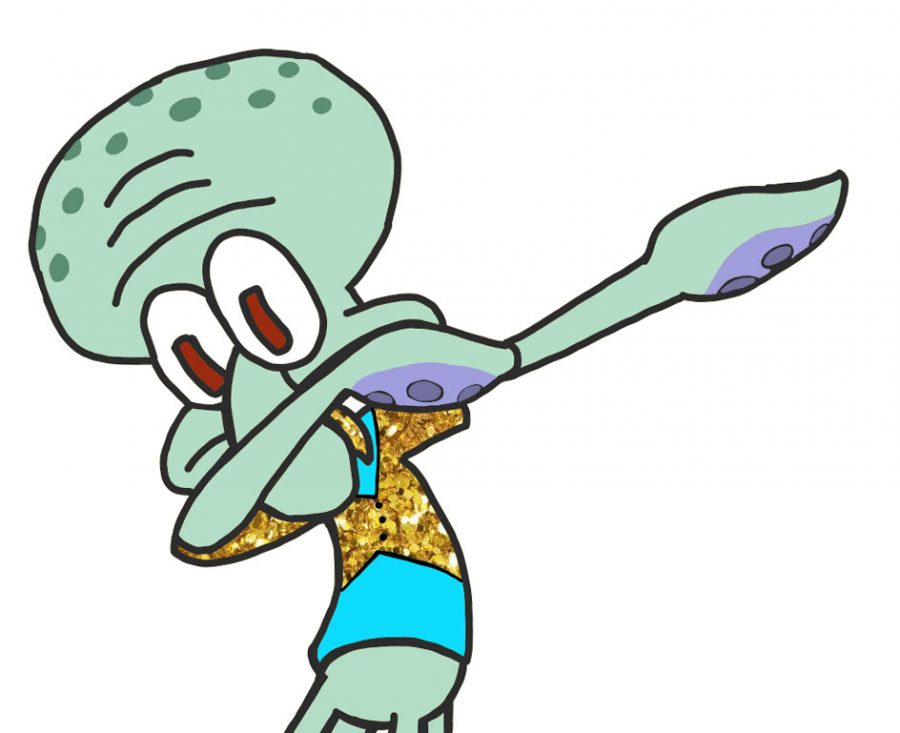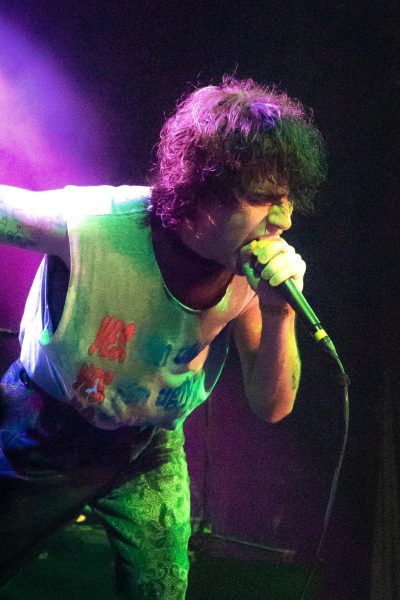‘The SpongeBob Musical’ is politically charged
February 11, 2020
Tony-winning production “SpongeBob SquarePants: The Broadway Musical” made its way to the Majestic Theatre, Jan. 24-26, for nostalgia-seeking 90s kids and begrudging parents alike. Both groups left with more life lessons, political commentary and uncomfortable romance than they could’ve expected.
By season four, the Flanderization of SpongeBob, in which the childishness of SpongeBob became his only attribute rather than one of many, seemed irreversible. Even the most die-hard fans will claim post-season three Spongebob is not the sponge they support. So, when SpongeBob found the spotlight, even the notoriety of Broadway couldn’t curb skepticism.
But when the curtains were drawn, the sponge — a human with orange-tinted hair and plaid pants, rather — on stage resembled the optimistic, loyal, heroic character of earlier seasons. Against the backdrop of Bikini Bottom’s flora in neon lights, familiar undersea creatures, such as Larry the Lobster and Old Man Jenkins, encounter SpongeBob one by one, annoyed by his cheery welcomes. Spongebob arrives at the Krusty Krab to start his workday as a fry cook and overhears his boss, Mr. Krabs, tell his daughter Pearl that she’d become manager of the restaurant one day, but she’s uninterested. In an homage to “The SpongeBob SquarePants Movie,” SpongeBob expresses interest in becoming manager, but Mr. Krabs calls him “just a simple sponge.” Before SpongeBob can express his sadness through song too much, an earthquake rocks Bikini Bottom.
News breaks that the volcano Mount Humongous will erupt and destroy the town in 24 hours. A town meeting is held, and Sandy Cheeks, SpongeBob’s squirrel friend, suggests science could stop the eruption. Plankton, whose actor wore an eyepatch, suggests leaving Bikini Bottom in an escape pod. Because it’s 2020, Plankton expresses this plan through rap fast enough to be likened to Eminem’s “Rap God.” Despite SpongeBob’s pleas to save the town he loves, the fish folk side with Plankton, not knowing his plan to hypnotize everyone inside the escape pod to love Chum, the food his restaurant serves, and send them all to Chumville. A mob hunts down Sandy, as they believe she’s the cause of the inevitable eruption. They turn “land mammal” into a species-ist chant, and its connection to racism today is apparent.
SpongeBob finds Sandy and convinces both her and Patrick, a starfish and SpongeBob’s best friend, to save the town with Sandy’s invention: the Eruptor Interrupter. This plan soon falls apart when cultish sardines, inspired by Patrick’s plan at the town meeting to close their eyes to stop the eruption, convince Patrick that he will be their savior. Patrick, craving the respect they gave him and his philosophical meditations such as “life smells weird,” takes the position of Super Sea Star Savior, leaving Sandy and SpongeBob to stop the eruption themselves.
After a dangerous climb up shifting ladders, SpongeBob and Sandy reach the top of Mount Humongous. Meanwhile, the sardine cult realizes the downfalls of praising fraudulent idols, and Patrick realizes he misses SpongeBob, so he joins them on top of Mount Humungous by propelling from the ceiling in a jetpack Sandy had conveniently invented before. With Patrick’s encouragement, SpongeBob throws the Eruptor Interrupter into the volcano. When the friends look down from the volcano, however, they find Bikini Bottom’s citizens fighting. They fly down just in time for SpongeBob to stop the chaos by reassuring his peers that they can still have the best day ever in the last few minutes of their lives. The neighbors hold fins, unifying themselves despite their differences, and when the clock strikes doomsday, bubbles float through the air, signaling that Sandy’s invention worked. She’s welcomed back into the community, Plankton’s plan is found out and Mr. Krabs tells SpongeBob that he could be manager one day.
The major success of this musical was its ability to not take itself seriously. Pearl questions the biology behind her, a whale, being a daughter to a crab. Old Man Jenkins breakdances during “The Best Day Ever.” Plankton schemes with his computer wife Karen for the first time in a long time, and he shares his intimate desire to be called “Big Guy” rather than his first name, Sheldon. She indulges this desire and pounces onto his lap, leaving the audience uncomfortably laughing. Called a loser by a band meant to put on a concert to raise funds for the escape pod, Squidward worries whether he is truly a loser, but a chorus line of sea anemone assures him that he’s “not delirious with despair and [he’s] not hallucinating this sea anemone chorus line at all.” In a quick change, Squidward emerges from the crowd of sea anemone wearing a bejeweled blue suit. He begins a tap dance routine and belts that he doesn’t “not like [himself] at all.” The pit even got involved in the musical. In the introductory song, SpongeBob threw a spatula to the conductor, who proceeded to conduct the orchestra with the kitchen tool.
Though based on a kid’s show, “The SpongeBob Musical,” as originally named for Broadway, should not be underestimated. Big names such as Panic! At the Disco, John Legend, David Bowie and Steven Tyler wrote songs for SpongeBob and his castmates, and in a tribute to the late Stephen Hillenburg, the creator of SpongeBob, the musical ended with “The SpongeBob Theme Song.” Tied with “Mean Girls,” “SpongeBob” held the most 2018 Tony nominations and won best scenic design for a musical. “SpongeBob” also snatched six wins at the 2018 Drama Desk Awards, the most for that year.
Motifs of unbreakable friendship, loyalty to the people and places you love, self-confidence in the face of insults and steadfastness when all hope is lost found their way into this musical starring a simple sponge. In today’s world of poverty, racism and some other third thing, we can “Look at the sun. It’s still shining. Look at the kelp. It’s still kelpy. Look at us. We still have each other.”












